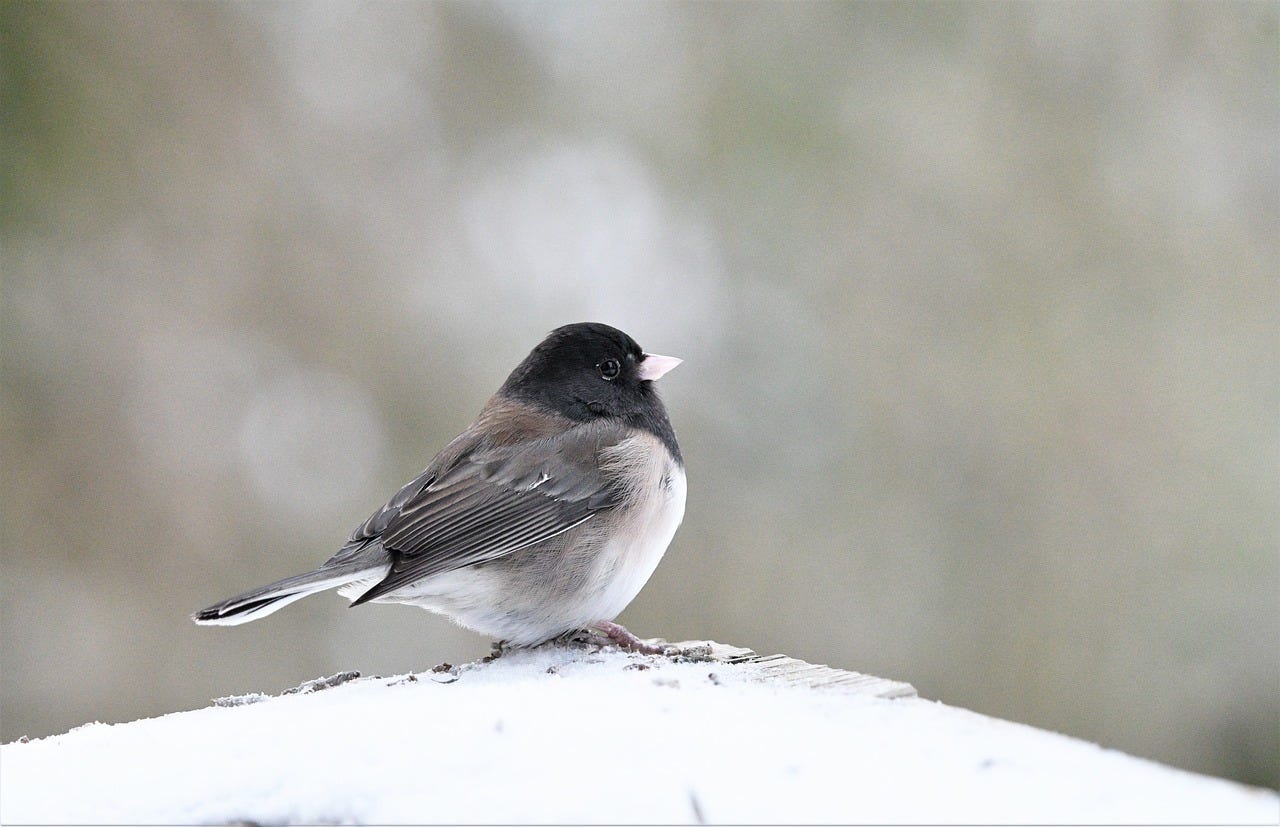
For the month of March, my essays (which are considerably shorter than usual) will focus on variations of nature themes.
Please enjoy the audio version of this essay here:
Today I am admiring the little birds congregating at the base of a home-crafted wooden feeder that Ben built me a few years ago for Mother’s Day. From the original group of six, a pair of slate gray dark-eyed juncos pecks at fallen seed, which had sunk into the melting snow. The other feathered friends are spooked by something I cannot see, maybe motion or a sudden sound, and they flee. But this pair of juncos remains at the foot of the feeder, bounding and foraging for those tiny seeds scattered close by, undaunted by their surroundings.
One of them flits to the feeder first. I watch him, careful not to make any sudden movements, while he pokes and prods the ground, then nibbles whatever scraps he unearths. His mate, I assume, joins him shortly, and he steps aside for her, while cocking his head to the side and springing in a circular motion around the base of the feeder’s pole.
She finds the birdseed, crunching each kernel in her tiny hooked beak, then ravenously inhaling another. And another. Her mate looks on, occasionally bobbing his head, as if to say, “Go ahead. Take what you need. I will wait to eat whatever is left.” He is not hurried, nor flustered, nor constricted by the confines of the clock. He waits for her to finish before approaching the area where she found the biggest pile of goods. She, in turn, hops around the feeder while he eats, observing her mate (or friend) satiate his hunger.
Today I realized that, while nature can be brutal and unforgiving, it can also be gratuitous in sharing its bounty.
Once, when my family of origin drove to Wyoming on a summer road trip, I gasped at the grandeur of witnessing a herd of bison grazing along the highway. I was ten at the time and fixated on the placid expressions of their faces, the ferocity in their yellow irises. “They’re so beautiful!” I said, and my mom quickly cautioned me with, “They’re also dangerous. They’ll rip you apart if you get too close.”
I knew that nature was feral, just as I knew that humans could be feral, too. There is something wild and untamed in all living things, which is what intrigued me as a child—and still does today. Then, I was afraid to come too close to the natural world, to step inside of it, because my mother’s fear kept me restrained and timorous. But her fear also tempered my impulse to run toward the bison. And I began to respect the power of nature, of savage beasts and lofty, majestic trees.
The little juncos, though, are like watching my sweet, approachable elderly neighbors. They are not rushed, and one always steps aside for the other to take his or her time. Maybe humans, in our aging and aching bodies, learn the lesson of slowing down because we must. But maybe the juncos know better than we, that nothing in our day is worth haste and hurry.
Your financial contribution helps supplement our family’s expenses and offset the costs of ongoing medical care for our daughter Sarah that requires 20 hours of unpaid caregiving on my part. I want you to know how much your support means and how it helps our family.





This is lovely, Jeannie. While reading, I found myself thinking about my favorite nature tome (besides Walden), The Outermost House by Henry Beston. He spent a whole year observing nature, mostly birds, from a small shack on the Cape Cod National Seashore. Think your family could spare you for a year? 🤣
Nature is the greatest teacher. Thank you for sharing its wisdom, Jeannie. ❤